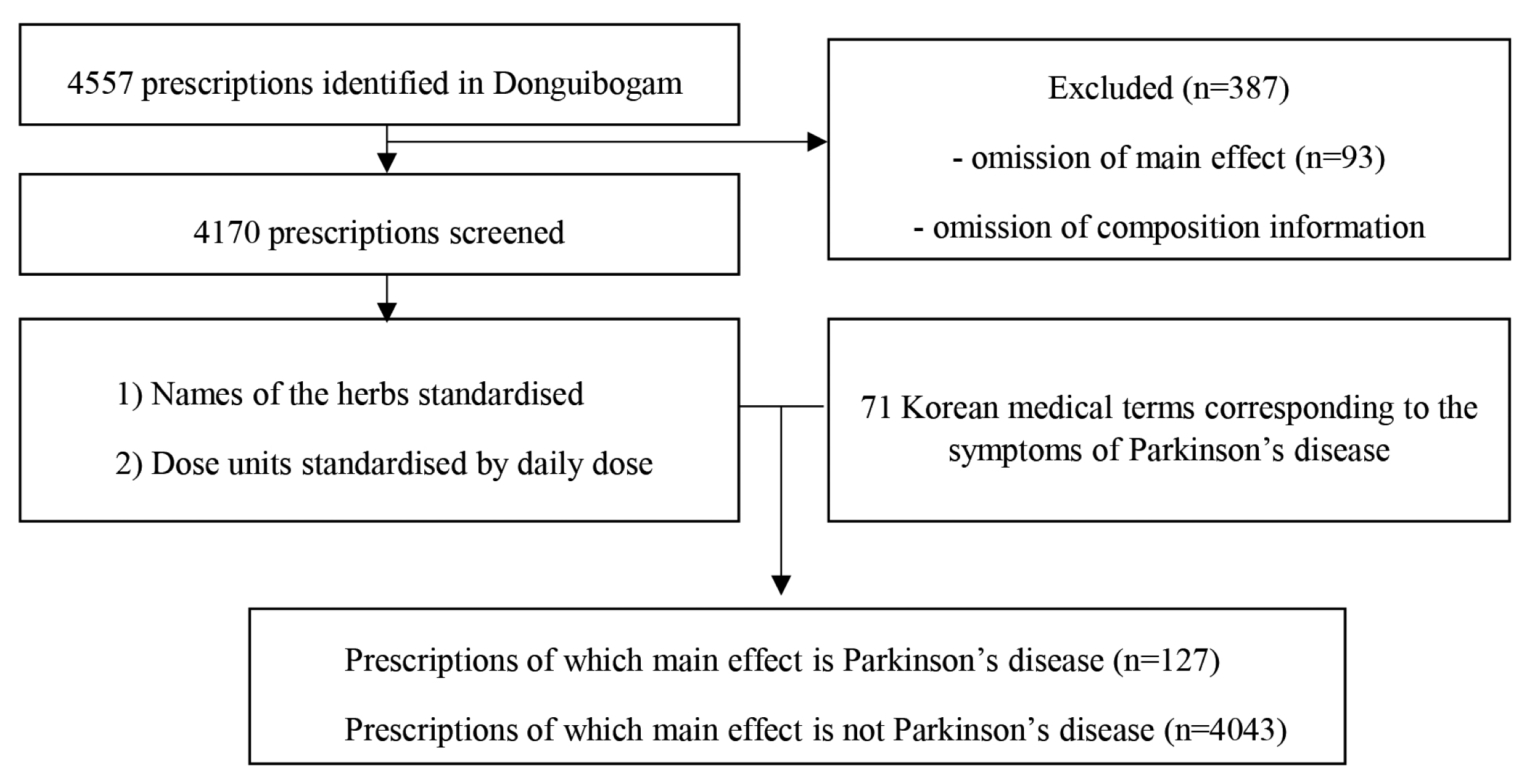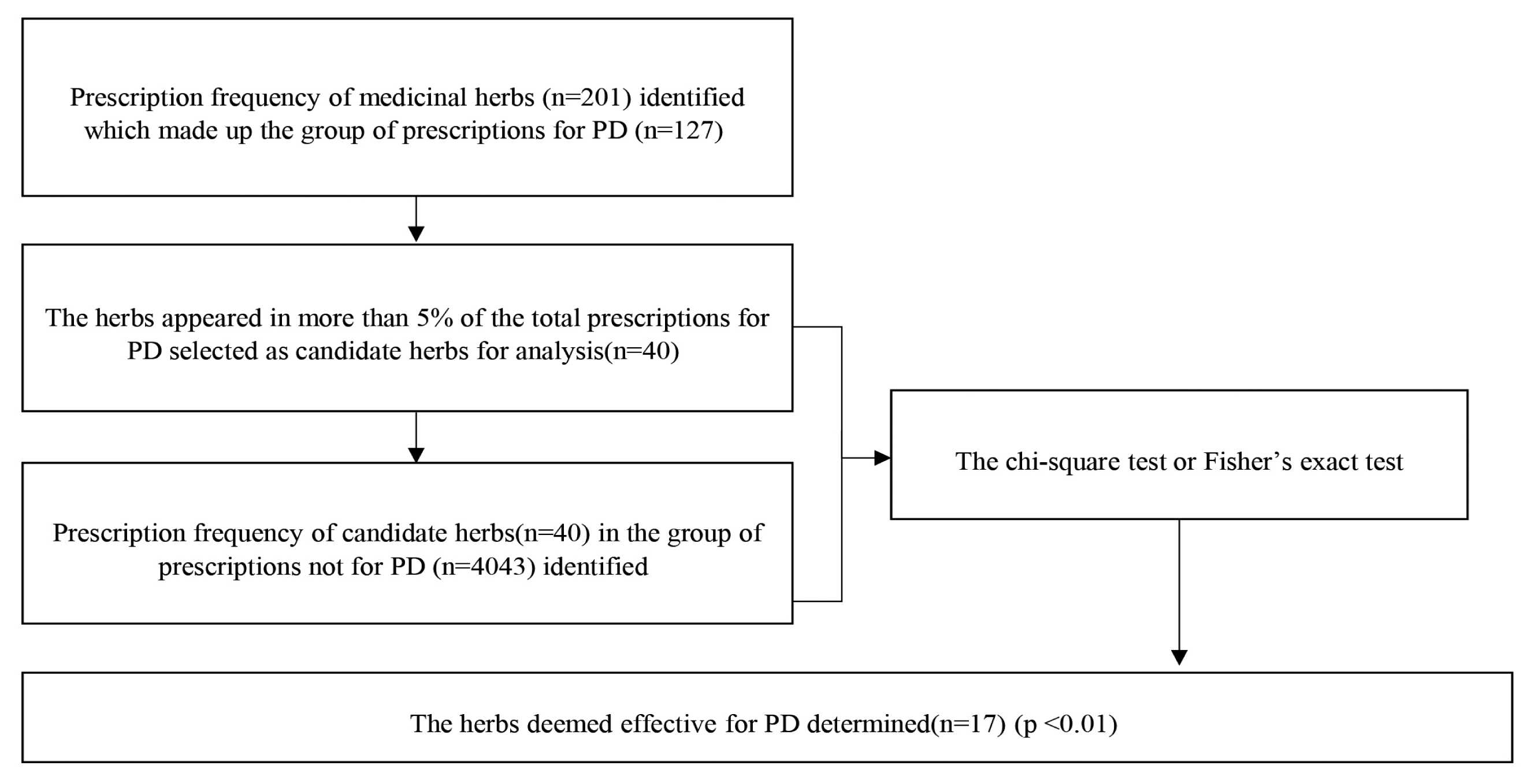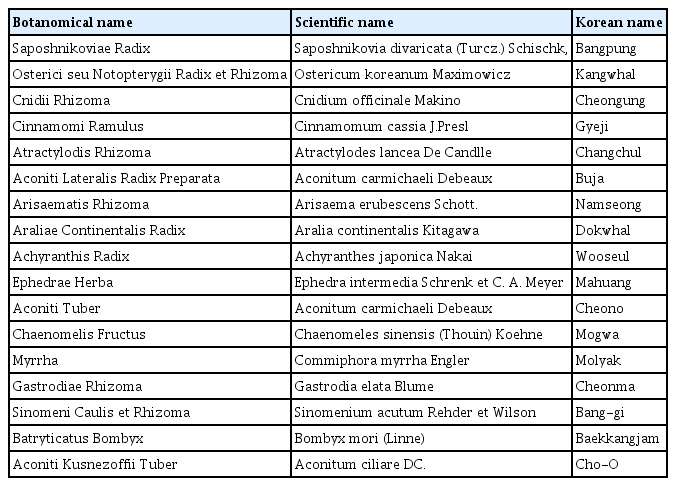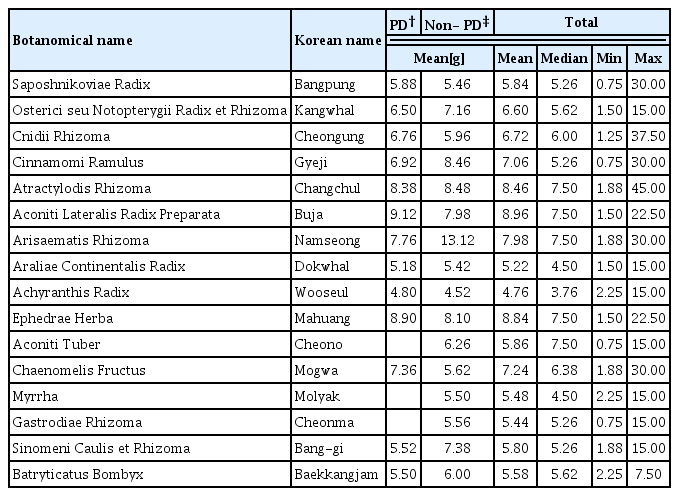Selection of Effective Herbal Medicines for Parkinson’s Disease Based on the Text Mining of the Classical Korean Medical Literature Donguibogam
Article information
Abstract
Objectives
The prevalence of Parkinson’s disease is on an upward trend along with an increase in the aging population but there is no available treatment that halts the progression of neurodegeneration. This study reports a numerical analysis on Donguibogam and suggests novel herbal drugs, which have never been researched before but found to be deemed effective in this study.
Methods
Referring to 71 Korean medicine symptom terms that represent the symptoms of Parkinson’s disease, 4170 prescriptions described in Donguibogam were classified into two groups based on whether their main effects were effective for Parkinson’s disease or not. Comparing the two groups, the chi-square test was performed to select statistically significant herbs, while the t-test, Wilcoxon test, and descriptive statistics were performed to determine the appropriate dose.
Results
One hundred and twenty-seven prescriptions effective for Parkinson’s disease were identified. The chi-square test determined 17 herbs that are effective for symptomatic treatment. Among the medicinal herbs, the authors suggest Osterici seu Notopterygii Radix et Rhizoma, Ephedrae Herba, Aconiti Tuber, Myrrha, Sinomeni Caulis et Rhizoma, and Aconiti Kusnezoffii Tuber as herbal candidates that have never been studied for Parkinson’s disease. Through the statistical tests, it was judged that the mean value of the dose of the entire prescription was the appropriate dose for each herb.
Conclusions
Seventeen herbs were selected for Parkinson’s disease and the appropriate daily dose were calculated. Furthermore, this study presented a new process that applies a statistical method to traditional medical literature and preselecting herbs deemed effective for specific diseases.
Introduction
Parkinson’s disease (PD) is a neurodegenerative disorder whose aetiology is not clearly identified. Medication therapy and deep brain stimulation are currently used to treat PD, but there is no available treatment that halts or decelerates the progression of neurodegeneration1). Levodopa, a prodrug to dopamine, and dopamine agonists are the core of medication therapy, and there are additional drug adjuvants to levodopa, including amantadine, β-blockers, catechol-O-methyl transferase inhibitors (e.g., tolcapone, entacapone) and anticholinergic drugs2,3,4). Levodopa is primarily aimed at symptomatic treatment and does not stop the progression of PD. In addition, the side effects of levodopa caused by administrative delays and the long-term risk of motor complications conclusively aggravate the patient’s quality of life5,6). Deep brain stimulation only offers symptomatic relief and has disadvantages, including side effects and additional battery replacement surgery when the battery runs out7).
In response to the growing demand for alternative treatment of Parkinson’s disease, numerous studies have been conducted to discover the therapeutic potential of medicinal herbs for PD and the National Institute for Korean Medicine Development (NIKOM) published the Clinical Practice Guideline for Parkinson’s Disease in 20208,9,10,11).
In general, the selection of candidate substances is made by paying attention to the well-known efficacy of the drugs or the specific main effect of the prescription. The main effect is the concept that a prescription mainly targets treatment with a synergistic effect of its constituent herbs according to the principle of traditional Korean medicine and is described in the form of Korean medicine symptom terms. This approach could yield guaranteed results but sometimes come up with limited vision on finding novel candidate substances. Thus, this study aims to provide a distinguished basis for finding effective herbs for PD by numerically analysing Donguibogam.
Donguibogam is a Korean classical medicinal literature completed in 1610, a thorough compilation, and an updated version of traditional medicine at the time12). In July 2009, UNESCO decided to add Donguibogam to the cultural heritage list because of its significance and contribution to the development of traditional medicine13). Donguibogam is a well-organised medical encyclopaedia which includes various medical knowledge of prescriptions, main effects, compositions of herbs, dosage, and other details. For this reason, this literature is worth studying as it is easy to obtain information through data analysis.
There is a previous study that discovered herbs deemed effective for PD in light of this statistical approach to Donguibogam14). However, there are constraints on the generalisability of the findings because the study only focused on rigidity among multiple symptoms of PD and the analysis was performed only to select frequently prescribed herbs for rigidity. Although PD symptoms are different for different people, diverse symptoms generally appear simultaneously.
The main symptoms of PD are bradykinesia, rigidity, and tremor. Also, various other motor and non-motor symptoms may appear15). Among the symptoms described on Donguibogam, this research targeted the symptoms that can be classified into main and other motor-related symptoms. The authors conducted a fresh approach to analyse Donguibogam with statistical techniques. The prescriptions described in Donguibogam were classified into two groups based on whether their main effects were efficacious for Parkinson’s disease or not. The authors compared the prescription frequency of the herbs in the two groups and then screened the medicinal herbs according to statistical significance. The chi-square test, t-test, and Wilcoxon test were used.
Besides, the authors suggest a list of herbal candidates deemed effective for PD for future experiments and an appropriate dosage range for them.
Materials and Methods
1. Standardisation of Symptom Terms
To identify the Donguibogam prescriptions deemed potentially effective for PD, Korean medicine symptom terms corresponding to PD were defined according to a previous study. The previous study targeted 7,443 symptom terms of Donguibogam text data provided by the Korean Intellectual Property Office (KIPO). In this study, specialists made use of the data and carried out the screening process. The specialists, consisting of one professor of Korean Medical Classics department and three graduate students majoring in Korean medicine, identified the meaning of every single term described in Donguibogam and selected 101 symptom terms in the first step. Duplicate terms were eliminated in the second step for significant results. One double-licensed Doctor of Medicine and Korean Medicine (M.D. and K.M.D.) and two life science professors advised this research16).
Korean medicine symptom terms matched with PD:
tremor: chì zòng(瘈瘲), jū luán(拘攣), jīngǔ juǎn(juǎn, quán) luán(筋骨卷(捲, 拳) 攣)), jīngǔ luán(luán) tòng(筋骨攣( 攣)痛), jīn luán(筋攣), jīn tì(筋惕), shǒu zhèn(手振), yang shǒu(揚手), luán jí(攣急), luán bì(攣庳), ròu rún(肉瞤), zhàn diào (戰掉), zhàn yáo(戰搖), zhì zú(擲足), chè tòng(掣痛), chōu chè(抽掣), fēng chù(風搐), chù nuò(搐搦)
rigidity: qiáng jí(强急), qiáng zhí(强直), qiáng tòng(强痛), jū jí(拘急), jīn jí(筋急), shēn qiáng(身强), luán jí(攣急), yāo jí qiáng(腰脊强), xiàng qiáng(項强)
other motor disturbance symptoms: jiān bēi shěn zhòng(肩背沈重), gǔ jiē téng tòng(骨節疼痛), gǔ zhòng(骨重), gǔ tòng(骨痛), jīn bì(筋痺), má mù(麻木), má bì(麻痺), bàn shēn bù shōu(半身不收), bù lǚ jiān kǔ(步履艱苦), bù suí(不隨), bù rén (不仁), bù suì(不遂), jīn gǔ téng tòng(筋骨疼痛), bèi xīn yī diǎn tòng(背心一點痛), bēi tòng(背痛), bì tòng(痺痛), sì zhī juàn dài(四肢倦怠), sì zhī wú lì(四肢無力), sì zhī huǎn ruò(四肢緩弱), shēn bì(身痺), yāo bēi suān téng(腰背酸疼), yāo bēi shí tòng(腰背時痛), yāo jǐ tòng(腰脊痛), lì fá(力乏), yāo jiǎo wú lì(腰脚無力), yāo tuǐ shěn zhòng(腰腿沈重), wěi(痿), zhū fēng(諸風), zhōu bì(周痺), zhōng fēng yī qiè zhū zhèng(中風一切諸證), zú xī tòng(足膝痛), zú ruò(足弱), zhī jié tòng(肢節痛), zhī tǐ téng tòng(肢體疼痛), duǒ yè(嚲曳), dǎ yè(打曳), tān huàn(癱瘓), fēng bì(風痺), fēng jí(風疾), xièyì(解㑊), zhī tǐ dài duò(肢體怠惰), sì zhī shěn zhòng(四肢沈重), piān kū(偏枯), xiàng jīn tòng(項筋痛)
2. Data Cleansing and Standardisation
A database was built using the following three steps. First, a data cleansing process was performed for all 4557 prescriptions on Donguibogam, the classical literature of traditional Korean medicine. Ninety-three prescriptions were excluded due to the omission of the main effect. A total of 294 prescriptions were excluded due to the omission of composition information. With this process, 4170 prescriptions were organised in the database. Second, medicinal herbs with synonymous names and sobriquets were unified under one name that is the most widely used. Third, dose units were standardised by 1-day dose when dose units of prescriptions described in the literature were different (e.g., single-dose, 1-day dose, or 10-day dose). The authors then applied 71 traditional Korean medicine symptom terms identified above to the database and 127 prescriptions, in which the main effect was identified as PD symptoms (Figure 1).
3. Chi-square test for selecting effective medicinal herbs
All prescriptions were grouped based on whether their main effect was for symptoms of PD, and the groups were named ‘a group of prescriptions for PD’ and ‘a group of prescriptions not for PD.’ The prescription frequency was identified by counting how often each of the 201 herbs appeared in 127 prescriptions for PD. And 40 herbs that appeared in more than 5% of the total prescriptions were selected. The 5% criterion is an arbitrary point to obtain sufficient prescription frequency for the following statistical analysis. Next, the prescription frequency of the candidate herbs not used for PD was identified. A chi-square test was performed to evaluate the statistically significant differences in the prescription frequency of the candidate herbs when used in the two groups (p < 0.01). However, in the chi-square test, Yate’s continuity correction was used when the expected frequency was 5–9, and Fisher’s exact test was used when the expected frequency was under 5 for more than 20% of the cells17) (Figure 2).
4. T-test and Wilcoxon test for determining the dose of medicinal herbs
Selected herbs were statistically verified to determine whether there was a difference in the dose when used in the two groups. When testing the selected herbs in the two prescription groups, a t-test was performed if the data followed a normal distribution, and the sample size was large enough (n = 30), while the Wilcoxon test, a nonparametric statistical hypothesis test, was performed if the data or the sample size did not meet the conditions (p < 0.05)18). The mean value, median value, maximum value, and minimum value were calculated to determine the recommended dose for each herb.
Only those prescriptions for which the dose regimen is clearly described in the literature, and the dosage form is brewing decoction, the most common form in traditional Korean medicine, were researched. Prescriptions of solid forms such as granules or external medicine and prescriptions for which the dose or dosing interval are not clearly described, were excluded.
Information regarding prescriptions, medicinal herbs, and main effects in Donguibogam was provided by the Korean Intellectual Property Office, the national patent office. The creation and application of the statistical methodology were done by the first author, who has a Master of Science in Statistics. Microsoft Excel 2016 and SAS version 9.4 were used for data processing and analysis.
Results
1. Medicinal Herbs Potentially Effective for PD
Among the total of 201 medicinal herbs used in 127 prescriptions for PD, 40 candidate herbs with a frequency of more than 5% of the total prescriptions were selected. And 17 herbs were identified to be potentially effective for PD treatment with statistical significance (p < 0.01) (Table 1, Table 2). In cases of Saposhnikoviae Radix, Osterici seu Notopterygii Radix et Rhizoma, Cnidii Rhizoma, Cinnamomi Ramulus, and Atractylodis Rhizoma, the chi-square test was used; Yate’s continuity correction was used for while the Fisher’s exact test was used for Aconiti Lateralis Radix Preparata and Arisaematis Rhizoma, while the Fisher’s exact test was used for Araliae Continentalis Radix, Achyranthis Radix, Ephedrae Herba, Aconiti Tuber, Chaenomelis Fructus, Myrrha, Gastrodiae Rhizoma, Sinomeni Caulis et Rhizoma, Batryticatus Bombyx, and Aconiti Kusnezoffii Tuber.
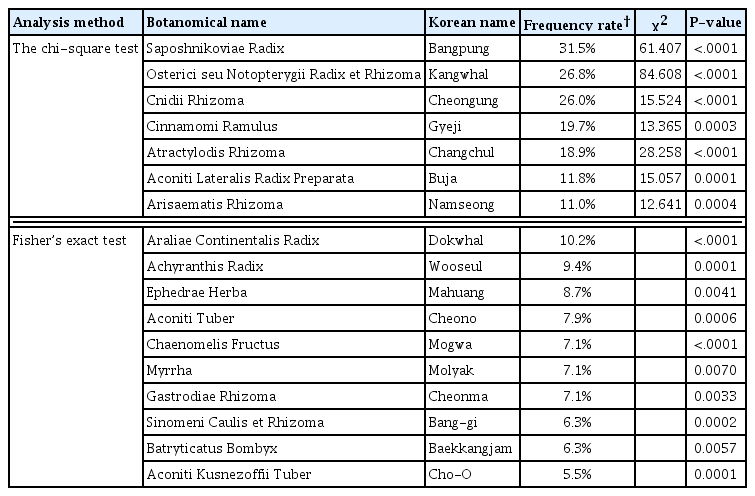
The result of the chi-square test and Fisher’s exact test for the herbs considered to be potentially effective for Parkinson’s Disease.
Osterici seu Notopterygii Radix et Rhizoma(χ2 = 84.608), Saposhnikoviae Radix (χ2 = 61.407), Atractylodis Rhizoma(χ2 = 28.258), Cnidii Rhizoma (χ2 = 15.524), Araliae Continentalis Radix (p < 0.0001), and Chaenomelis Fructus (p < 0.0001) were identified specifically for PD, as their chi-square values were very high or p-values were very low.
The remaining 23 herbs were statistically rejected, as there was no significant difference in the results of the chi-square test performed for the herbs in the two groups, even though the frequency of appearance in the prescriptions was high.
2. Proper Dose for Medicinal Herbs
Among the 17 herbs selected above, Osterici seu Notopterygii Radix et Rhizoma, Aconiti Lateralis Radix Preparata, Arisaematis Rhizoma, Achyranthis Radix, Chaenomelis Fructus, Sinomeni Caulis et Rhizoma, and Batryticatus Bombyx showed a normal distribution on the Shapiro-Wilk test; hence, they were further analysed using the t-test. The Wilcoxon test was used for Saposhnikoviae Radix, Cnidii Rhizoma, Cinnamomi Ramulus, Araliae Continentalis Radix, Atractylodis Rhizoma, and Ephedrae Herba as these herbs did not follow a normal distribution. There was no significant difference in the dose of medicinal herbs used in the two groups (p < 0.05). Aconiti Tuber, Myrrha, Gastrodiae Rhizoma, and Aconiti Kusnezoffii Tuber were excluded from the analysis because there was insufficient data to investigate the appropriate dose of these herbs.
In cases of Aconiti Tuber, Myrrha, and Gastrodiae Rhizoma, the mean and median values of all prescriptions were obtained and are described in Table 3. Aconiti Kusnezoffii Tuber was excluded because all prescriptions for this herb were in the form of a solid. For numerical analysis, the ‘mean value of dose of each herb used in the two groups for daily dose’ and ‘mean, median, minimum, and maximum value of dose of each herb used in all prescriptions for daily dose’ were calculated and are shown in Table 3.
Discussion
This research conducted a process of statistical analysis on Donguibogam, the traditional literature of Korean medicine for finding herbal candidates deemed effective for PD to identify a list of candidate herbs.
Based on the idea that herbs prescribed with the highest frequency are more likely to be effective, 40 herbs that made up more than 5% of the total prescriptions used for treating PD were searched and selected for analysis. Glycyrrhiza uralensis, Saposhnikoviae Radix, Osterici seu Notopterygii Radix et Rhizoma, Cnidii Rhizoma, Angelicae Gigantis Radix, Paeoniae Radix, and Ginseng Radix were prescribed more than 25 prescriptions among the 127 total prescriptions, being the most frequently prescribed herbs in the list and they could be considered candidate substances. However, when it comes to experimental research trying to find candidate herbs more likely to be effective, additional information including statistical values would increase the success rate of the research. In addition, comparatively less frequently prescribed herbs still could be on the list of candidate substances if there is additional information.
In the first analysis, the chi-square test was used to verify the difference of prescription frequency of herbs in the two groups and 17 herbs were selected for potentially treating PD. This was derived from the fact that those herbs were more statistically significant in the group of prescriptions for PD than in the prescription group not for PD.
Among them, Saposhnikoviae Radix, Osterici seu Notopterygii Radix et Rhizoma, Cnidii Rhizoma, and Cinnamomi Ramulus were included in the top 10 frequently used herbs. The four herbs are more reliable to be candidate substances deemed effective for PD because we found out the fact through the statistical tests that the herbs have been more specifically used for PD symptoms.
A notable part of this research is that Araliae Continentalis Radix, Achyranthis Radix, Chaenomelis Fructus, Sinomeni Caulis et Rhizoma, Aconiti Tuber, and Aconiti Kusnezoffii Tuber were found to be relatively infrequently prescribed herbs but eventually selected to be deemed effective herbs. If the prescription frequency was only considered, they would not have been suitable candidate substances. However, the herbs were tested using Fisher’s exact test and found to be more statistically significantly used in the group of prescriptions for PD than in the group of prescriptions not for PD, which means they have been more specifically used for PD symptoms. (p-value < 0.001) In this way, additional information that which herbs are specific to which disease gives opportunities to embrace novel herbs into the list of candidate substances that otherwise would have been unthinkable.
It was possible to determine the priority order among selected herbs based on the chi-square value or the p-value. The higher the chi-square value and the lower the p-value, the more pronounced the difference between the two groups. The priority order of Saposhnikoviae Radix and Osterici seu Notopterygii Radix et Rhizoma was calculated based on chi-square values and that of Araliae Continentalis Radix and Chaenomelis Fructus was calculated based on p-values as these herbs were tested using Fisher’s exact test.
Among the herbs on the list, 11 herbs were previously researched. According to the systematic review by Su Yeon Lim et al., Batryticatus Bombyx, Gastrodiae Rhizoma, Achyranthis Radix, Aconiti Tuber, and Arisaematis Rhizoma have been prescribed for PD19). Xin-Chun Jin et al. reported in the systematic review that Cnidii Rhizoma was used as a single agent and a prescription included both Batryticatus Bombyx and Gastrodiae Rhizoma for treating PD20). Hwan Soo Joo et al. reported that Gastrodiae Rhizoma was used as a single agent and a newly developed prescription for PD included Batryticatus Bombyx, Saposhnikoviae Radix, Cinnamomi Ramulus, and Chaenomelis Fructus as ingredients21). Previous studies reported that Araliae Continentalis Radix and Cinnamomi Ramulus could be utilised for treating PD22,23).
Saposhnikoviae Radix, Cnidii Rhizoma, Araliae Continentalis Radix, and Atractylodis Rhizoma are also on a list of candidate substances for treating PD suggested by previous text mining research on rigidity with Donguibogam14). In contrast to the past studies, the authors paid close attention to the prescription frequency of herbs for PD and other diseases and determined the listed herbs have been prescribed specifically for PD. Also, this research broadened the for the analysis while the previous research focused on rigidity.
Therefore, this research suggests Osterici seu Notopterygii Radix et Rhizoma, Ephedrae Herba, Aconiti Tuber, Myrrha, Sinomeni Caulis et Rhizoma, and Aconiti Kusnezoffii Tuber as novel candidate substances for treating PD. The six herbs have been researched for their clinical effectiveness for other diseases. However, never has there been any research for PD conducted with the six herbs.
According to the recent studies, Osterici seu Notopterygii Radix et Rhizomahas the effect of treating immunological diseases such as allergic reactions24), Aconiti Tuber could improve low levels of serotonin in the medulla25), Ephedrae Herba exhibits inhibitory effects on neuroinflammation26) Sinomeni Caulis et Rhizoma ameliorates neuropsychological problems including insomnia, depression, and inflammation by affecting GABA, norepinephrine, 5-hydroxytryptamine27,28,29) and Myrrha has anti-neuroinflammation effect30). These findings that these herbs have neurological, immunological efficacies imply the possibility that the drugs may also be effective for treating PD.
The second analysis was designed and performed with a hypothesis that medicinal herbs deemed effective for PD had been prescribed with a larger dose for PD. However, there was no significant difference in the dose of medicinal herbs used in the two groups. Therefore, when determining the appropriate dose of medicinal herbs, it is not necessary to focus on difference between the two groups, but it is reasonable to refer to the overall mean or median values.
Since this study selected medicinal herbs from Donguibogam, the original literature, its limitation is that it requires experimental verification. We could not confirm whether the selected herbs are effective in treating the PD symptoms, and therefore future experimental research is necessary to authenticate their effectiveness.
This study aims to find the herbs solely used for PD symptoms, not every single herbal drug effective for PD treatment. Thus, herbs used not only for PD, but also other diseases have been excluded from the list. The authors started this research with the premise that herbs specifically prescribed with high frequency are more likely to be effective for a specific disease. Therefore, the limitation is that the assumption of this study is not always applicable in all cases. However, this analysis may provide a new perspective on finding novel candidate herbs deemed effective for PD. It also takes a short period, especially 3–4 weeks in this research. As statistical process of analysis could be utilised for the development of future novel drugs for other diseases, the authors standardisation and utilisation of this process.
Conclusions
Saposhnikoviae Radix, Osterici seu Notopterygii Radix et Rhizoma, Cnidii Rhizoma, Cinnamomi Ramulus, Atractylodis Rhizoma, Aconiti Lateralis Radix Preparata, Arisaematis Rhizoma, Araliae Continentalis Radix, Achyranthis Radix, Ephedrae Herba, Aconiti Tuber, Chaenomelis Fructus, Myrrha, Gastrodiae Rhizoma, Sinomeni Caulis et Rhizoma, Batryticatus Bombyx, and Aconiti Kusnezoffii Tuber were selected as herbs potentially effective for treating PD. Since there was no significant difference in the dose of individual herbs used in the two groups for a daily dose, we speculated that the average dose of the entire prescription would be appropriate for each herb.
Furthermore, this study presented quantitative statistical evidence for obtaining a list of medicinal herbs and appropriate dose for each herb useful for treating PD by applying the chi-square test, t-test, and Wilcoxon test to Donguibogam, the original literature.
Acknowledgment
This work was supported by the Health Fellowship Foundation.

